Chengjian Feng
Seedance 1.5 pro: A Native Audio-Visual Joint Generation Foundation Model
Dec 23, 2025Abstract:Recent strides in video generation have paved the way for unified audio-visual generation. In this work, we present Seedance 1.5 pro, a foundational model engineered specifically for native, joint audio-video generation. Leveraging a dual-branch Diffusion Transformer architecture, the model integrates a cross-modal joint module with a specialized multi-stage data pipeline, achieving exceptional audio-visual synchronization and superior generation quality. To ensure practical utility, we implement meticulous post-training optimizations, including Supervised Fine-Tuning (SFT) on high-quality datasets and Reinforcement Learning from Human Feedback (RLHF) with multi-dimensional reward models. Furthermore, we introduce an acceleration framework that boosts inference speed by over 10X. Seedance 1.5 pro distinguishes itself through precise multilingual and dialect lip-syncing, dynamic cinematic camera control, and enhanced narrative coherence, positioning it as a robust engine for professional-grade content creation. Seedance 1.5 pro is now accessible on Volcano Engine at https://console.volcengine.com/ark/region:ark+cn-beijing/experience/vision?type=GenVideo.
RoboTron-Sim: Improving Real-World Driving via Simulated Hard-Case
Aug 06, 2025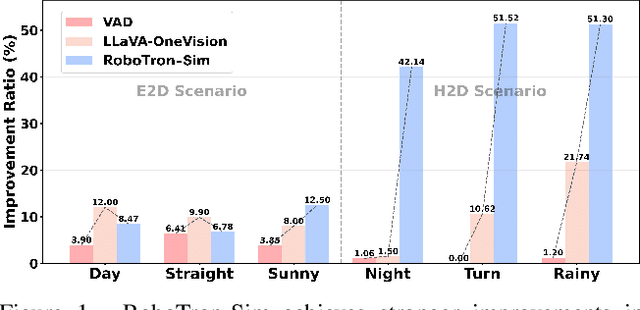


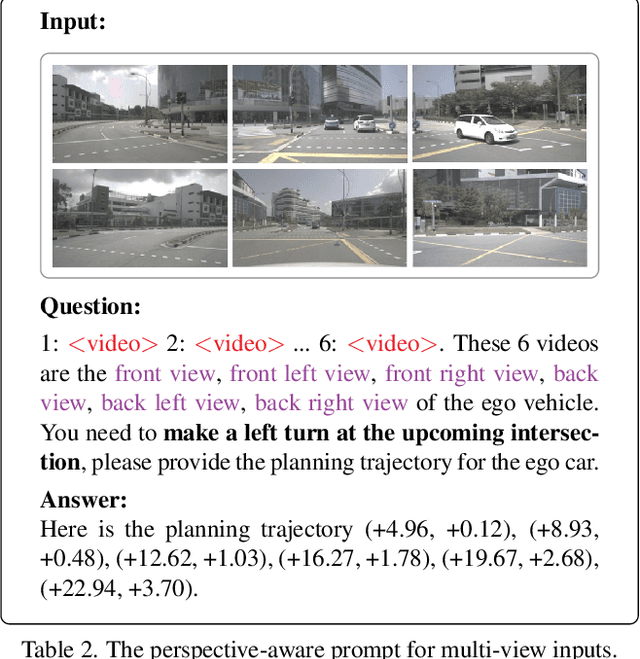
Abstract:Collecting real-world data for rare high-risk scenarios, long-tailed driving events, and complex interactions remains challenging, leading to poor performance of existing autonomous driving systems in these critical situations. In this paper, we propose RoboTron-Sim that improves real-world driving in critical situations by utilizing simulated hard cases. First, we develop a simulated dataset called Hard-case Augmented Synthetic Scenarios (HASS), which covers 13 high-risk edge-case categories, as well as balanced environmental conditions such as day/night and sunny/rainy. Second, we introduce Scenario-aware Prompt Engineering (SPE) and an Image-to-Ego Encoder (I2E Encoder) to enable multimodal large language models to effectively learn real-world challenging driving skills from HASS, via adapting to environmental deviations and hardware differences between real-world and simulated scenarios. Extensive experiments on nuScenes show that RoboTron-Sim improves driving performance in challenging scenarios by around 50%, achieving state-of-the-art results in real-world open-loop planning. Qualitative results further demonstrate the effectiveness of RoboTron-Sim in better managing rare high-risk driving scenarios. Project page: https://stars79689.github.io/RoboTron-Sim/
X-SAM: From Segment Anything to Any Segmentation
Aug 06, 2025Abstract:Large Language Models (LLMs) demonstrate strong capabilities in broad knowledge representation, yet they are inherently deficient in pixel-level perceptual understanding. Although the Segment Anything Model (SAM) represents a significant advancement in visual-prompt-driven image segmentation, it exhibits notable limitations in multi-mask prediction and category-specific segmentation tasks, and it cannot integrate all segmentation tasks within a unified model architecture. To address these limitations, we present X-SAM, a streamlined Multimodal Large Language Model (MLLM) framework that extends the segmentation paradigm from \textit{segment anything} to \textit{any segmentation}. Specifically, we introduce a novel unified framework that enables more advanced pixel-level perceptual comprehension for MLLMs. Furthermore, we propose a new segmentation task, termed Visual GrounDed (VGD) segmentation, which segments all instance objects with interactive visual prompts and empowers MLLMs with visual grounded, pixel-wise interpretative capabilities. To enable effective training on diverse data sources, we present a unified training strategy that supports co-training across multiple datasets. Experimental results demonstrate that X-SAM achieves state-of-the-art performance on a wide range of image segmentation benchmarks, highlighting its efficiency for multimodal, pixel-level visual understanding. Code is available at https://github.com/wanghao9610/X-SAM.
DisTime: Distribution-based Time Representation for Video Large Language Models
May 30, 2025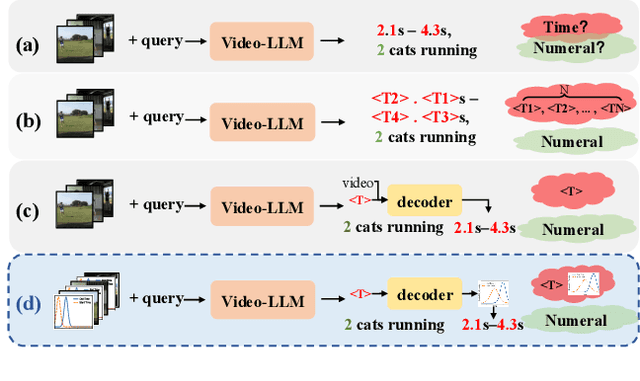
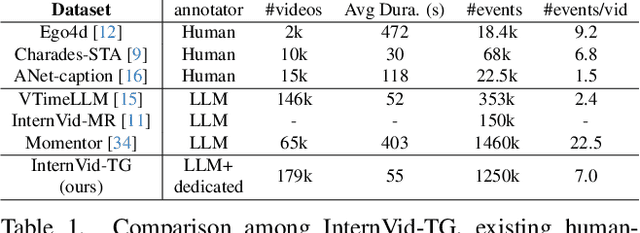
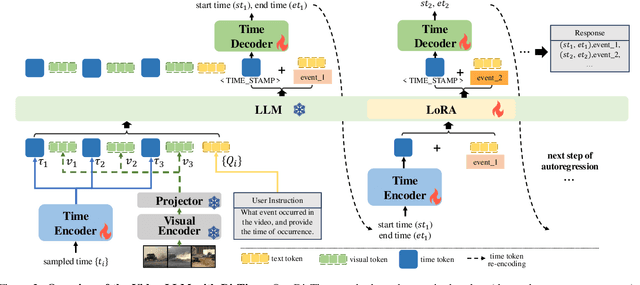

Abstract:Despite advances in general video understanding, Video Large Language Models (Video-LLMs) face challenges in precise temporal localization due to discrete time representations and limited temporally aware datasets. Existing methods for temporal expression either conflate time with text-based numerical values, add a series of dedicated temporal tokens, or regress time using specialized temporal grounding heads. To address these issues, we introduce DisTime, a lightweight framework designed to enhance temporal comprehension in Video-LLMs. DisTime employs a learnable token to create a continuous temporal embedding space and incorporates a Distribution-based Time Decoder that generates temporal probability distributions, effectively mitigating boundary ambiguities and maintaining temporal continuity. Additionally, the Distribution-based Time Encoder re-encodes timestamps to provide time markers for Video-LLMs. To overcome temporal granularity limitations in existing datasets, we propose an automated annotation paradigm that combines the captioning capabilities of Video-LLMs with the localization expertise of dedicated temporal models. This leads to the creation of InternVid-TG, a substantial dataset with 1.25M temporally grounded events across 179k videos, surpassing ActivityNet-Caption by 55 times. Extensive experiments demonstrate that DisTime achieves state-of-the-art performance across benchmarks in three time-sensitive tasks while maintaining competitive performance in Video QA tasks. Code and data are released at https://github.com/josephzpng/DisTime.
AP-CAP: Advancing High-Quality Data Synthesis for Animal Pose Estimation via a Controllable Image Generation Pipeline
Apr 01, 2025Abstract:The task of 2D animal pose estimation plays a crucial role in advancing deep learning applications in animal behavior analysis and ecological research. Despite notable progress in some existing approaches, our study reveals that the scarcity of high-quality datasets remains a significant bottleneck, limiting the full potential of current methods. To address this challenge, we propose a novel Controllable Image Generation Pipeline for synthesizing animal pose estimation data, termed AP-CAP. Within this pipeline, we introduce a Multi-Modal Animal Image Generation Model capable of producing images with expected poses. To enhance the quality and diversity of the generated data, we further propose three innovative strategies: (1) Modality-Fusion-Based Animal Image Synthesis Strategy to integrate multi-source appearance representations, (2) Pose-Adjustment-Based Animal Image Synthesis Strategy to dynamically capture diverse pose variations, and (3) Caption-Enhancement-Based Animal Image Synthesis Strategy to enrich visual semantic understanding. Leveraging the proposed model and strategies, we create the MPCH Dataset (Modality-Pose-Caption Hybrid), the first hybrid dataset that innovatively combines synthetic and real data, establishing the largest-scale multi-source heterogeneous benchmark repository for animal pose estimation to date. Extensive experiments demonstrate the superiority of our method in improving both the performance and generalization capability of animal pose estimators.
DataPlatter: Boosting Robotic Manipulation Generalization with Minimal Costly Data
Mar 25, 2025Abstract:The growing adoption of Vision-Language-Action (VLA) models in embodied AI intensifies the demand for diverse manipulation demonstrations. However, high costs associated with data collection often result in insufficient data coverage across all scenarios, which limits the performance of the models. It is observed that the spatial reasoning phase (SRP) in large workspace dominates the failure cases. Fortunately, this data can be collected with low cost, underscoring the potential of leveraging inexpensive data to improve model performance. In this paper, we introduce the DataPlatter method, a framework that decouples training trajectories into distinct task stages and leverages abundant easily collectible SRP data to enhance VLA model's generalization. Through analysis we demonstrate that sub-task-specific training with additional SRP data with proper proportion can act as a performance catalyst for robot manipulation, maximizing the utilization of costly physical interaction phase (PIP) data. Experiments show that through introducing large proportion of cost-effective SRP trajectories into a limited set of PIP data, we can achieve a maximum improvement of 41\% on success rate in zero-shot scenes, while with the ability to transfer manipulation skill to novel targets.
DriveMM: All-in-One Large Multimodal Model for Autonomous Driving
Dec 10, 2024



Abstract:Large Multimodal Models (LMMs) have demonstrated exceptional comprehension and interpretation capabilities in Autonomous Driving (AD) by incorporating large language models. Despite the advancements, current data-driven AD approaches tend to concentrate on a single dataset and specific tasks, neglecting their overall capabilities and ability to generalize. To bridge these gaps, we propose DriveMM, a general large multimodal model designed to process diverse data inputs, such as images and multi-view videos, while performing a broad spectrum of AD tasks, including perception, prediction, and planning. Initially, the model undergoes curriculum pre-training to process varied visual signals and perform basic visual comprehension and perception tasks. Subsequently, we augment and standardize various AD-related datasets to fine-tune the model, resulting in an all-in-one LMM for autonomous driving. To assess the general capabilities and generalization ability, we conduct evaluations on six public benchmarks and undertake zero-shot transfer on an unseen dataset, where DriveMM achieves state-of-the-art performance across all tasks. We hope DriveMM as a promising solution for future end-toend autonomous driving applications in the real world.
RoboMM: All-in-One Multimodal Large Model for Robotic Manipulation
Dec 10, 2024



Abstract:In recent years, robotics has advanced significantly through the integration of larger models and large-scale datasets. However, challenges remain in applying these models to 3D spatial interactions and managing data collection costs. To address these issues, we propose the multimodal robotic manipulation model, RoboMM, along with the comprehensive dataset, RoboData. RoboMM enhances 3D perception through camera parameters and occupancy supervision. Building on OpenFlamingo, it incorporates Modality-Isolation-Mask and multimodal decoder blocks, improving modality fusion and fine-grained perception. RoboData offers the complete evaluation system by integrating several well-known datasets, achieving the first fusion of multi-view images, camera parameters, depth maps, and actions, and the space alignment facilitates comprehensive learning from diverse robotic datasets. Equipped with RoboData and the unified physical space, RoboMM is the generalist policy that enables simultaneous evaluation across all tasks within multiple datasets, rather than focusing on limited selection of data or tasks. Its design significantly enhances robotic manipulation performance, increasing the average sequence length on the CALVIN from 1.7 to 3.3 and ensuring cross-embodiment capabilities, achieving state-of-the-art results across multiple datasets.
RFSR: Improving ISR Diffusion Models via Reward Feedback Learning
Dec 04, 2024Abstract:Generative diffusion models (DM) have been extensively utilized in image super-resolution (ISR). Most of the existing methods adopt the denoising loss from DDPMs for model optimization. We posit that introducing reward feedback learning to finetune the existing models can further improve the quality of the generated images. In this paper, we propose a timestep-aware training strategy with reward feedback learning. Specifically, in the initial denoising stages of ISR diffusion, we apply low-frequency constraints to super-resolution (SR) images to maintain structural stability. In the later denoising stages, we use reward feedback learning to improve the perceptual and aesthetic quality of the SR images. In addition, we incorporate Gram-KL regularization to alleviate stylization caused by reward hacking. Our method can be integrated into any diffusion-based ISR model in a plug-and-play manner. Experiments show that ISR diffusion models, when fine-tuned with our method, significantly improve the perceptual and aesthetic quality of SR images, achieving excellent subjective results. Code: https://github.com/sxpro/RFSR
AutoM3L: An Automated Multimodal Machine Learning Framework with Large Language Models
Aug 01, 2024Abstract:Automated Machine Learning (AutoML) offers a promising approach to streamline the training of machine learning models. However, existing AutoML frameworks are often limited to unimodal scenarios and require extensive manual configuration. Recent advancements in Large Language Models (LLMs) have showcased their exceptional abilities in reasoning, interaction, and code generation, presenting an opportunity to develop a more automated and user-friendly framework. To this end, we introduce AutoM3L, an innovative Automated Multimodal Machine Learning framework that leverages LLMs as controllers to automatically construct multimodal training pipelines. AutoM3L comprehends data modalities and selects appropriate models based on user requirements, providing automation and interactivity. By eliminating the need for manual feature engineering and hyperparameter optimization, our framework simplifies user engagement and enables customization through directives, addressing the limitations of previous rule-based AutoML approaches. We evaluate the performance of AutoM3L on six diverse multimodal datasets spanning classification, regression, and retrieval tasks, as well as a comprehensive set of unimodal datasets. The results demonstrate that AutoM3L achieves competitive or superior performance compared to traditional rule-based AutoML methods. Furthermore, a user study highlights the user-friendliness and usability of our framework, compared to the rule-based AutoML methods.
 Add to Chrome
Add to Chrome Add to Firefox
Add to Firefox Add to Edge
Add to Edge